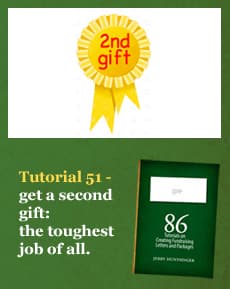Tutorial 51: get a second gift: the toughest job of all
Bad news for entry-level fundraisers.
- Written by
- Jerry Huntsinger
- Added
- January 09, 2019

When you send out a prospecting letter, and new donors respond – most of them will never give you a second gift.
Never. Count on it.
Why does this happen? Probably because a lot of new donors respond on a sudden impulse. Then later, if that impulse is not triggered again, they are not interested. Their life has moved on.
So how do you attack this situation? You begin with – yes – a thank-you letter. Only instead of the same type of letter you might send repeat donors, you turn it into a New Donor Thank You Letter.
When an individual contributes to your organisation for the first time, you must provide a special kind of thank-you letter.
Here’s where you stand. A new donor has made a gift. Your appeal letter was successful. The donor has trusted you with the first half of a warm and positive experience.
But the routine thank-you letter will not complete that experience for a new donor. The donor knows this is a first-time gift. Your thank-you letter must come right out and say, ‘I am so pleased to welcome you to our family of contributors.’
Express that sentiment in several ways, several times in one letter.
Also, begin your educational campaign with the new donor thank-you letter. Provide a complete description of the work of your organisation.
Regardless of the format you use for your thank-you letter, timing is a critical factor.
If your new donor has to wait four or five weeks for a thank you, then you really shouldn’t expect your programme to be successful in getting second gifts.
I’ve heard just about every excuse you can imagine as to why it’s impossible to ‘turn around’ a thank-you five days or less, but, after all the excuses are on the table, it still boils down to one simple fact. Your donor doesn’t care about the 10,000 pieces of mail you receive every Monday morning. All she cares about is the one piece that comes to her.
Many organisations say ‘we can get out a form letter in a few days, but a personalised letter will take several weeks.’ If that is the case, then probably it is better to get out a form letter within five days than wait five weeks for a personal letter.
Should your new donor thank-you letter be hard sell or soft sell? This depends on the nature of your organisation and the particular campaign in which you are involved. Not every new donor thank-you letter should be hard sell, but at times, if you are in the midst of a major programme, you may wish to make the thank-you letter an extension of the fundraising appeal and go right on asking for money for that specific project.
One technique that is vastly under-rated is the simple act of putting a stamped reply envelope into the thank-you package. Try it! You will be pleasantly surprised.
Of course, you will have donors who tell you that you are wasting postage, but that is an easier problem to handle than donors who never think about you at all.
So, what do you say to that new donor you just enrolled? You’ve invested a lot of money (maybe $5 to $25). You want the donor to give you repeat gifts. You want the donor to upgrade.
How do you get this process started?
Here is a quick draft of a typical ‘welcome’ letter. It’s a little flat because it’s for educational purposes only. You can improve on it.
The letter is from our imaginary organisation in Washington, DC, called the Mission Center.
The basic outline is rather simple:
- A ‘thank you’ for the gift with a reference to the amount.
- An acknowledgment that the donor is new to the organisation.
- A brief summary of what the organisation does and the challenges it faces.
- And end up with references to some kind of an enclosure giving the new donor complete information about the philosophy and challenge of the organisation.
‘Welcome to our family’ letter
Mr John Q Sample
123 Any Street
Anytown, USA 00000
Dear Mr Sample,
Thank you so much for sharing with us your generous contribution of $25. It’s much appreciated.
I believe this is the first time you have sent a gift to the Mission Center, and I’m always thrilled when folks like you step forward and share with those less fortunate.
Please believe me, we need new friends like you!
Never before in the history of our Mission have we had so many children, adults and elderly folks coming to us – lost – or desperately hungry – or abandoned by their loved ones - or even on the brink of suicide...
... like ‘Gloria’, a teenage girl who had been walking the streets for 10 days after her boyfriend had beaten her because she refused to work as a prostitute and give him the money.
She told us that all she wanted was to get one good hot meal in her stomach and then she was going to take her life. She couldn’t bear to die while she was still hungry!
And, Mr Sample, generous gifts like the one you sent made it possible for us to give this girl a hot meal and then get her into a drug rehabilitation programme. Later she even went back to high school.
Page 2
Of course, not all the impoverished people who come to the Mission Center find a happy solution to their problems. But we help them the best we can, by carefully budgeting the resources donors like you provide.
And so to keep you informed of our work here in the nation’s capitol, from time to time I’ll be telling you about the challenges that face us and reporting to you on how your support is being utilised.
For now, I’m enclosing one of our leaflets giving you some photographs of the Mission Center in action, along with a statement of our purpose and philosophy, plus a summary of our latest financial report.
It’s so good to know that you believe in the work of the Mission Center!
Again, thanks so much for remembering us and if you have any questions, please don’t hesitate to write to me. I would love to hear from you.
Sincerely,
xxxxxxxxxx
P.S. This has been a long, cold winter for many homeless people in the inner city, and so I have enclosed a reply envelope for your convenience, in case you wish to make another gift at this time.
© SOFII Foundation 2010-2014.


















